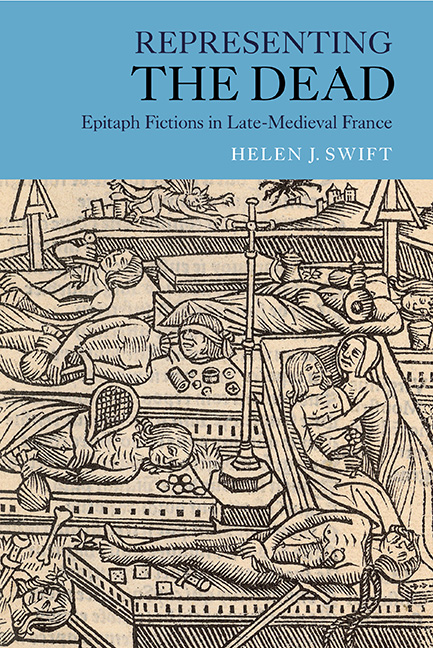Book contents
- Frontmatter
- Dedication
- Contents
- List of Illustrations
- Acknowledgements
- Note on Quotations
- List of Abbreviations
- Chronology of Epitaph Fictions
- Introduction: Representing the Dead
- 1 Framing Identity: ‘je suis’ and ‘cy gist’
- 2 Identity and/as Echo: the ‘Belle Dame’ querelle and Le Jardin de plaisance
- 3 Dying to be told: storytelling and exemplarity ‘selon le stile Jehan Bocace’
- 4 Placing the Dead: Cemeteries, Hospitals and Temples
- Afterword: Illustrating the dead
- Coda: Re-Member Me
- Appendix: Early Editions of the Jardin de plaisance et fleur de rethorique
- Bibliography
- Index
- Already Published
Afterword: Illustrating the dead
Published online by Cambridge University Press: 17 June 2021
- Frontmatter
- Dedication
- Contents
- List of Illustrations
- Acknowledgements
- Note on Quotations
- List of Abbreviations
- Chronology of Epitaph Fictions
- Introduction: Representing the Dead
- 1 Framing Identity: ‘je suis’ and ‘cy gist’
- 2 Identity and/as Echo: the ‘Belle Dame’ querelle and Le Jardin de plaisance
- 3 Dying to be told: storytelling and exemplarity ‘selon le stile Jehan Bocace’
- 4 Placing the Dead: Cemeteries, Hospitals and Temples
- Afterword: Illustrating the dead
- Coda: Re-Member Me
- Appendix: Early Editions of the Jardin de plaisance et fleur de rethorique
- Bibliography
- Index
- Already Published
Summary
I have been striving throughout this book to problematise the relationship between death and identity by viewing posthumous name and renown not as rigidly memorialised but as malleable identity narratives and echoes. Such narratives are forged in a mode of being-after-life which is not readily or simply definable in terms of life or death, presence or absence, and which writers are interested in exploring through play with and/or disruption of these binaries: we recall the ‘echo life’ of Chartier's Belle Dame (Chapter 2) or Lemaire's and Bouchet's juggling with ‘trespas’/‘transmigration’ and ‘mort’/‘trespas’ (Chapter 4). Imaginative fiction furnishes a crucible for such conceptual experimentation, and we can see late-medieval writers to have deployed their epitaph fictions to reflect on key questions of literary representation more generally: the construction and control of identity, the slipperiness of narrative voice and the very capacities of fictional writing itself. Chapter 4 concluded on the essential relationship between death and textuality; in this Afterword, I wish briefly to consider a visual dimension in terms of the role of book illustration.
The number of images found in manuscript and print copies of epitaph fictions is at first sight disappointingly low, since one might have expected the descriptive richness of their literary representations to have inspired numerous portraits of the dead housed in their cemeteries, hospitals and temples. However, that would be to assume, first, that the primary function of illustration is to visualise what is recounted in the text, and, second, that what is described is in fact susceptible to representation as a sufficiently coherent, visualisable entity. The possible functions of miniatures and woodcuts are, of course, many and varied, and the nature of text/image relations in the material presentation of vernacular literature of this period is a still developing field of enquiry. We saw in Chapter 3 how a programme of miniatures devised for a manuscript of Chastelain's TB appeared to implement a coherent, specific agenda: privileging issues of narrative layering, character interaction and point of view – a set of concerns not entirely separate from the text, but certainly extrapolating from it, as well as deploying images to serve a structuring role in foregrounding TB's narrative framework. Pictures may also, for instance, serve a marketing role in the context of title-page woodcuts for early printed texts.
Information
- Type
- Chapter
- Information
- Representing the DeadEpitaph Fictions in Late-Medieval France, pp. 265 - 304Publisher: Boydell & BrewerPrint publication year: 2016
